One Step Synthesis of Tetragonal-CuBi2O4/Amorphous-BiFeO3 Heterojunction with Improved Charge Separation and Enhanced Photocatalytic Properties
Abstract
:1. Introduction
2. Materials and Methods
2.1. Preparation
2.2. Characterization
2.3. Photocatalytic Activity Measurement
3. Results and Discussions
3.1. Crystal Structure, Morphology, and Composition
3.2. Optical and Electronic Properties
3.3. Photocatalytic Properties
3.4. Stability of the T-CBO/A-BFO (1:1) Composite
4. Conclusions
Supplementary Materials
Author Contributions
Funding
Acknowledgments
Conflicts of Interest
References
- Meng, X.; Zhang, Z. Bismuth-based photocatalytic semiconductors: Introduction, challenges and possible approaches. J. Mol. Catal. A Chem. 2016, 423, 533–549. [Google Scholar] [CrossRef]
- He, R.; Cao, S.; Zhou, P.; Yu, J. Recent advances in visible light Bi-based photocatalysts. Chin. J. Catal. 2014, 35, 989–1007. [Google Scholar] [CrossRef]
- Abdi, F.F.; Berglund, S.P. Recent developments in complex metal oxide photoelectrodes. J. Phys. D Appl. Phys. 2017, 50, 193002. [Google Scholar] [CrossRef]
- Kang, D.; Hill, J.C.; Park, Y.; Choi, K.-S. Photoelectrochemical properties and photostabilities of high surface area CuBi2O4 and Ag-doped CuBi2O4 photocathodes. Chem. Mater. 2016, 28, 4331–4340. [Google Scholar] [CrossRef]
- Guo, F.; Shi, W.; Wang, H.; Huang, H.; Liu, Y.; Kang, Z. Fabrication of a CuBi2O4/g-C3N4 p–n heterojunction with enhanced visible light photocatalytic efficiency toward tetracycline degradation. Inorg. Chem. Front. 2017, 4, 1714–1720. [Google Scholar] [CrossRef]
- Wang, F.; Chemseddine, A.; Abdi, F.F.; Krol, R.v.d.; Berglund, S.P. Spray pyrolysis of CuBi2O4 photocathodes: Improved solution chemistry for highly homogeneous thin films. J. Mater. Chem. A. 2017, 5, 12838–12847. [Google Scholar] [CrossRef]
- Li, M.Y.; Tang, Y.-B.; Shi, W.-L.; Chen, F.-Y.; Shi, Y.; Gu, H.C. Design of visible-light-response core–shell Fe2O3/CuBi2O4 heterojunctions with enhanced photocatalytic activity towards the degradation of tetracycline: Z-scheme photocatalytic mechanism insight. Inorg. Chem. Front. 2018, 5, 3148–3154. [Google Scholar] [CrossRef]
- Chen, X.; Dai, Y.; Guo, J. Hydrothermal synthesis of well-distributed spherical CuBi2O4 with enhanced photocatalytic activity under visible light irradiation. Mater. Lett. 2015, 161, 251–254. [Google Scholar] [CrossRef]
- Wang, Y.; Cai, F.; Guo, P.; Lei, Y.; Xi, Q.; Wang, F. Short-Time Hydrothermal Synthesis of CuBi2O4 Nanocolumn Arrays for Efficient Visible-Light Photocatalysis. Nanomaterials 2019, 9, 1257. [Google Scholar] [CrossRef] [Green Version]
- Lam, S.M.; Sin, J.C.; Mohamed, A.R. A newly emerging visible light-responsive BiFeO3 perovskite for photocatalytic applications: A mini review. Mater. Res. Bull. 2017, 90, 15–30. [Google Scholar] [CrossRef]
- Shang, J.; Chen, H.; Chen, T.; Wang, X.; Feng, G.; Zhu, M.; Yang, Y.; Jia, X. Photocatalytic degradation of rhodamine B and phenol over BiFeO3/BiOCl nanocomposite. Appl. Phys. A 2019, 125, 1331–1337. [Google Scholar] [CrossRef]
- Sahni, M.; Kumar, D.; Chauhan, S.; Singh, M.; Kumar, N. Study of structural, optical and photocatalytic activity of Sm and Ni doped BiFeO3 (BFO) and BFO@ZnO nanostructure. Mater. Today Proc. 2020, 28, 56–60. [Google Scholar] [CrossRef]
- Sivula, K.; Roel, V.D.K. Semiconducting materials for photoelectrochemical energy conversion. Nat. Rev. Mater. 2016, 1, 15010. [Google Scholar] [CrossRef]
- Henrich, V.E.; Cox, P.A. The Surface Science of Metal Oxides; Cambridge University Press: Cambridge, UK, 1994. [Google Scholar] [CrossRef] [Green Version]
- Wang, F.; Septina, W.; Chemseddine, A.; Abdi, F.F.; Friedrich, D.; Bogdanoff, P.; Krol, R.v.d.; Tilley, S.D.; Berglund, S.P. Gradient self-doped CuBi2O4 with highly improved charge separation efficiency. J. Am. Chem. Soc. 2017, 139, 15094–15103. [Google Scholar] [CrossRef] [PubMed] [Green Version]
- Sheu, Y.M.; Trugman, S.A.; Xiong, J.; Park, Y.S.; Lee, S.; Yi, H.T.; Cheong, S.W.; Jia, Q.X.; Taylor, A.J.; Prasankumar, R.P. Ultrafast carrier dynamics and radiative recombination in multiferroic BiFeO3 single crystals and thin films. In Proceedings of EPJ Web of Conferences; EDP Sciences: Les Ulis, France, 2013; Volume 41, p. 03018. [Google Scholar] [CrossRef] [Green Version]
- Sheikh, M.S.; Ghosh, D.; Bhowmik, T.K.; Dutta, A.; Bhattacharyya, S.; Sinha, T.P. When multiferroics become photoelectrochemical catalysts: A case study with BiFeO3/La2NiMnO6. Mater. Chem. Phys. 2020, 244, 122685. [Google Scholar] [CrossRef]
- Berglund, S.P.; Abdi, F.F.; Bogdanoff, P.; Chemseddine, A.; Friedrich, D.; Krol, R.v.d. Comprehensive Evaluation of CuBi2O4 as a photocathode material for photoelectrochemical water splitting. Chem. Mater. 2016, 28, 4231–4242. [Google Scholar] [CrossRef]
- Wei, L.; Shifu, C.; Sujuan, Z.; Wei, Z.; Huaye, Z.; Xiaoling, Y. Preparation and characterization of p–n heterojunction photocatalyst p-CuBi2O4/n-TiO2 with high photocatalytic activity under visible and UV light irradiation. J. Nanopart. Res. 2009, 12, 1355–1366. [Google Scholar] [CrossRef]
- Deng, Y.; Chen, Y.; Chen, B.; Ma, J. Preparation, characterization and photocatalytic activity of CuBi2O4/NaTaO3 coupled photocatalysts. J. Alloys Compd. 2013, 559, 116–122. [Google Scholar] [CrossRef]
- Abdelkader, E.; Nadjia, L.; Ahmed, B. Preparation and characterization of novel CuBi2O4/SnO2 p–n heterojunction with enhanced photocatalytic performance under UVA light irradiation. J. King Saud Univ. Sci. 2015, 27, 76–91. [Google Scholar] [CrossRef] [Green Version]
- Elaziouti, A.; Laouedj, N.; Bekka, A.; Vannier, R.-N. Preparation and characterization of p–n heterojunction CuBi2O4/CeO2 and its photocatalytic activities under UVA light irradiation. J. King Saud Univ. Sci. 2015, 27, 120–135. [Google Scholar] [CrossRef] [Green Version]
- Yuan, X.; Shen, D.; Zhang, Q.; Zou, H.; Liu, Z.; Peng, F. Z-scheme Bi2WO6/CuBi2O4 heterojunction mediated by interfacial electric field for efficient visible-light photocatalytic degradation of tetracycline. Chem. Eng. J. 2019, 369, 292–301. [Google Scholar] [CrossRef]
- Shi, H.; Fan, J.; Zhao, Y.; Huc, X.; Zhang, X.; Tang, Z. Visible light driven CuBi2O4/Bi2MoO6 p-n heterojunction with enhanced photocatalytic inactivation of E. coli and mechanism insight. J. Hazard. Mater. 2020, 381, 121006. [Google Scholar] [CrossRef] [PubMed]
- Samran, B.; Saranyoo, C. Highly enhanced photoactivity of BiFeO3/Bi2WO6 composite films under visible light irradiation. Physica B 2019, 575, 411683. [Google Scholar] [CrossRef]
- Mishra], B.G. Photocatalytic degradation of alachlor using type-II CuS/BiFeO3 heterojunctions as novel photocatalyst under visible light irradiation. Chem. Eng. J. 2018, 344, 391–401. [Google Scholar] [CrossRef]
- Di, L.; Yang, H.; Xian, T.; Chen, X. Facile Synthesis and Enhanced Visible-Light Photocatalytic Activity of Novel p-Ag3PO4/n-BiFeO3 Heterojunction Composites for Dye Degradation. Nanoscale Res. Lett. 2018, 13, 257. [Google Scholar] [CrossRef]
- Niu, F.; Chen, D.; Qin, L.; Zhang, N.; Wang, J.; Chen, Z.; Huang, Y. Facile Synthesis of Highly Efficient p-n Heterojunction CuO/BiFeO3 Composite Photocatalysts with Enhanced Visible-Light Photocatalytic Activity. Chemcatchem 2015. [Google Scholar] [CrossRef]
- Soltani, T.; Tayyebi, A.; Lee, B.-K. BiFeO3/BiVO4 p−n heterojunction for efficient and stable photocatalytic and photoelectrochemical water splitting under visible-light irradiation. Catal. Today 2018, 340, 188–196. [Google Scholar] [CrossRef]
- Hu, X.; Wang, W.; Xie, G.; Wang, H.; Tan, X.; Jin, Q.; Zhou, D.; Zhao, Y. Ternary assembly of g-C3N4/graphene oxide sheets /BiFeO3 heterojunction with enhanced photoreduction of Cr(VI) under visible-light irradiation. Chemosphere 2019, 216, 733–741. [Google Scholar] [CrossRef]
- Theerthagiri, J.; Chandrasekaran, S.; Salla, S.; Elakkiya, V.; Senthil, R.A.; Nithyadharseni, P.; Maiyalagan, T.; Micheal, K.; Ayeshamariam, A.; Arasu, M.V.; et al. Recent developments of metal oxide based heterostructures for photocatalytic applications towards environmental remediation. J. Solid State Chem. 2018, 267, 35–52. [Google Scholar] [CrossRef]
- De Mendonça, V.R.; Dalmaschio, C.J.; Leite, E.R.; Niederberger, M.; Ribeiro, C. Heterostructure formation from hydrothermal annealing of preformed nanocrystals. J. Mater. Chem. A 2015, 3, 2216–2225. [Google Scholar] [CrossRef]
- Wang, F.; Yang, H.; Zhang, Y. Enhanced photocatalytic performance of CuBi2O4 particles decorated with Ag nanowires. Mater. Sci. Semicond. Process. 2018, 73, 58–66. [Google Scholar] [CrossRef]
- Zhang, Y.C.; Yang, H.; Wang, W.P.; Zhang, H.M.; Li, R.S.; Wang, X.X.; Yu, R.C. A promising supercapacitor electrode material of CuBi2O4 hierarchical microspheres synthesized via a coprecipitation route. J. Alloys Compd. 2016, 684, 707–713. [Google Scholar] [CrossRef]
- Elaziouti, A.; Laouedj, N.; Bekka, A. Synergetic effects of Sr-doped CuBi2O4 catalyst with enhanced photoactivity under UVA- light irradiation. Environ. Sci. Pollut. Res. Int. 2016, 23, 15862–15876. [Google Scholar] [CrossRef] [PubMed]
- Duan, Q.; Kong, F.; Han, X.; Jiang, Y.; Liu, T.; Chang, Y.; Zhou, L.; Qin, G.; Zhang, X. Synthesis and characterization of morphology-controllable BiFeO3 particles with efficient photocatalytic activity. Mater. Res. Bull. 2019, 112, 104–108. [Google Scholar] [CrossRef]
- Li, Y.; Wang, X.-T.; Zhang, X.-Q.; Li, X.; Wang, J.; Wang, C.-W. New hydrothermal synthesis strategy of nano-sized BiFeO3 for high-efficient photocatalytic applications. Phys. E Low Dimens. Syst. Nanostruct. 2020, 118, 113865. [Google Scholar] [CrossRef]
- Yuvaraj, S.; Karthikeyan, K.; Kalpana, D.; Lee, Y.S.; Selvan, R.K. Surfactant-free hydrothermal synthesis of hierarchically structured spherical CuBi2O4 as negative electrodes for Li-ion hybrid capacitors. J. Colloid Interface Sci. 2016, 469, 47–56. [Google Scholar] [CrossRef]
- Zhang, F.; Saxena, S. Raman studies of Bi2CuO4 at high pressures. Appl. Phys. Lett. 2006, 88, 141926. [Google Scholar] [CrossRef]
- Popović, Z.; Kliche, G.; Cardona, M.; Liu, R. Vibrational properties of Bi2CuO4. Phys. Rev. B Condens. Matter 1990, 41, 3824–3828. [Google Scholar] [CrossRef]
- Najafian, H.; Manteghi, F.; Beshkar, F.; Salavati-Niasari, M. Fabrication of nanocomposite photocatalyst CuBi2O4/Bi3ClO4 for removal of acid brown 14 as water pollutant under visible light irradiation. J. Hazard. Mater. 2019, 361, 210–220. [Google Scholar] [CrossRef]
- Gao, H.; Wang, F.; Wang, S.; Wang, X.; Yi, Z.; Yang, H. Photocatalytic activity tuning in a novel Ag2S/CQDs/CuBi2O4 composite: Synthesis and photocatalytic mechanism. Mater. Res. Bull. 2019, 115, 140–149. [Google Scholar] [CrossRef]
- Shi, W.; Guo, F.; Yuan, S. In situ synthesis of z-scheme Ag3PO4/CuBi2O4 photocatalysts and enhanced photocatalytic performance for the degradation of tetracycline under visible light irradiation. Appl. Catal. B Environ. 2017, 209, 720–728. [Google Scholar] [CrossRef]
- Yang, J.; Du, C.; Wen, Y.; Zhang, Z.; Cho, K.; Chen, R.; Shan, B. Enhanced photoelectrochemical hydrogen evolution at p-type CuBi2O4 photocathode through hypoxic calcination. Int. J. Hydrog. Energy 2018, 43, 9549–9557. [Google Scholar] [CrossRef]
- Chen, Y.; Zhang, Y.; Luo, L.; Shi, Y.; Wang, S.; Li, L.; Long, Y.; Jiang, F. A novel templated synthesis of C/N-doped β-Bi2O3 nanosheets for synergistic rapid removal of 17α-ethynylestradiol by adsorption and photocatalytic degradation. Ceram. Int. 2017, 44, 2178–2185. [Google Scholar] [CrossRef]
- Yang, S.; Chen, C.; Liu, L.; Zhu, L.; Xu, X. Facile fabrication of micro-floriated AgBr/Bi2O3 as highly efficient visible-light photocatalyst. Mater. Res. Bull. 2017, 92, 29–38. [Google Scholar] [CrossRef]
- Claros, M.; Setka, M.; Jimenez, Y.P.; Vallejos, S. AACVD Synthesis and Characterization of Iron and Copper Oxides Modified ZnO Structured Films. Nanomaterials 2020, 10, 471. [Google Scholar] [CrossRef] [PubMed] [Green Version]
- Zalecki, R.; Woch, W.M.; Kowalik, M.; Kolodziejczyk, A.; Gritzner, G. Bismuth Valence in a Tl0.7Bi0.3Sr1.6Ba0.4CaCu2Oy Superconductor from X-Ray Photoemission Spectroscopy. Acta Phys. Pol. A 2010, 118, 393–398. [Google Scholar] [CrossRef]
- Huo, Y.; Jin, Y.; Zhang, Y. Citric acid assisted solvothermal synthesis of BiFeO3 microspheres with high visible-light photocatalytic activity. J. Mol. Catal. A Chem. 2010, 331, 15–20. [Google Scholar] [CrossRef]
- Luo, W.; Zhu, L.; Wang, N.; Tang, H.; Cao, M.; She, Y. Efficient Removal of Organic Pollutants with Magnetic Nanoscaled BiFeO3 as a Reusable Heterogeneous Fenton-Like Catalyst. Environ. Sci. Technol. 2010, 44, 1786–1791. [Google Scholar] [CrossRef]
- Di, L.; Yang, H.; Xian, T.; Chen, X. Enhanced photocatalytic degradation activity of BiFeO3 microspheres by decoration with g-C3N4 nanoparticles. Mater. Res. 2018, 21. [Google Scholar] [CrossRef] [Green Version]
- Fatima, S.; Ali, S.I.; Younas, D.; Islam, A.; Akinwande, D.; Rizwan, S. Graphene nanohybrids for enhanced catalytic activity and large surface area. MRS Commun. 2019, 9, 27–36. [Google Scholar] [CrossRef] [Green Version]
- Jiang, Z.; Geng, Y.; Gu, D. Write-once medium with BiOx thin films for blue laser recording. Chin. Opt. Lett. 2008, 6, 1671–7694. [Google Scholar] [CrossRef]
- Zuo, W.; Zhu, W.; Zhao, D.; Sun, Y.; Li, Y.; Liu, J.; Lou, X.W.D. Bismuth oxide: A versatile high-capacity electrode material for rechargeable aqueous metal-ion batteries. Energy Environ. Sci. 2016, 9, 2881–2891. [Google Scholar] [CrossRef]


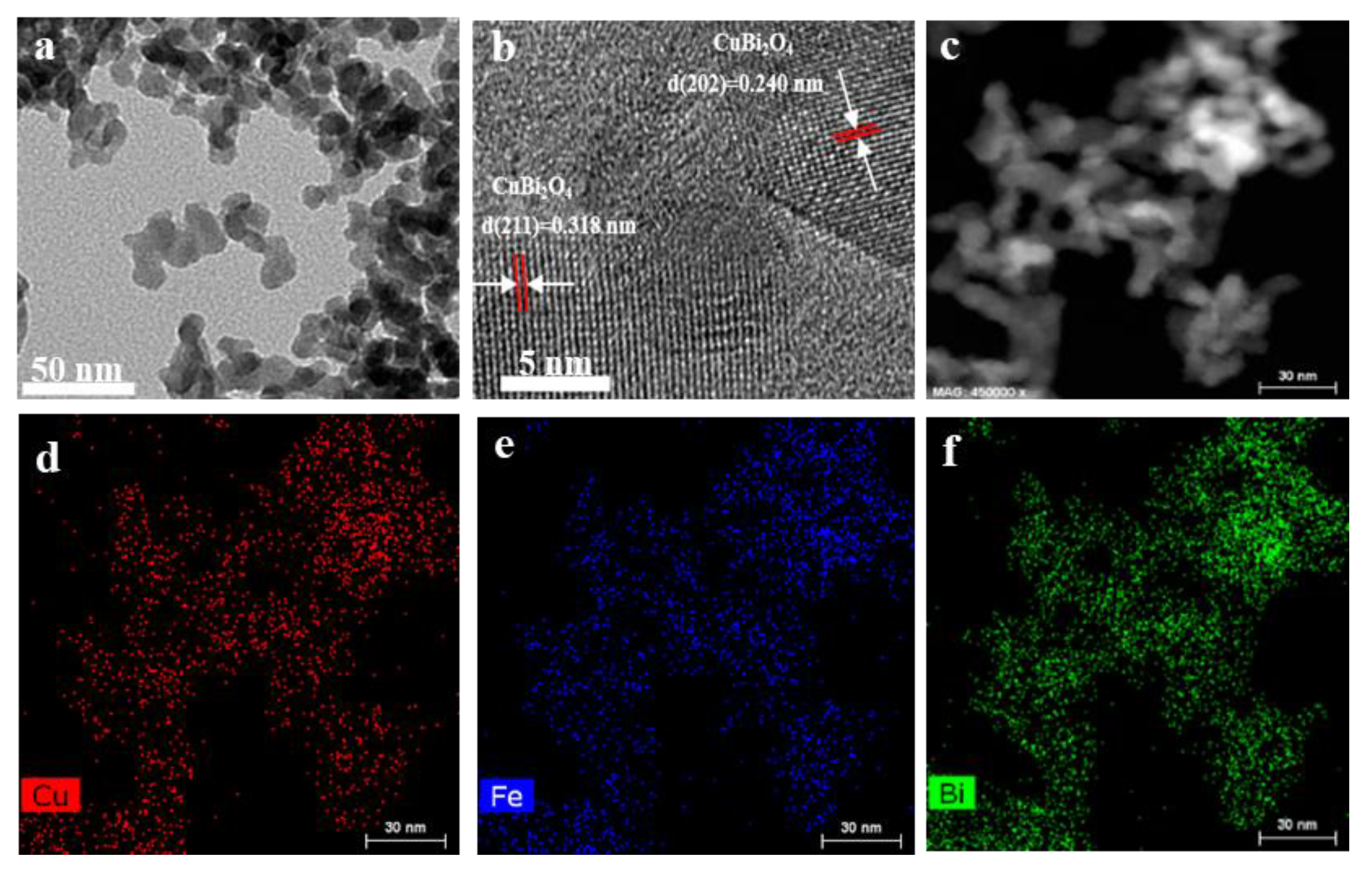
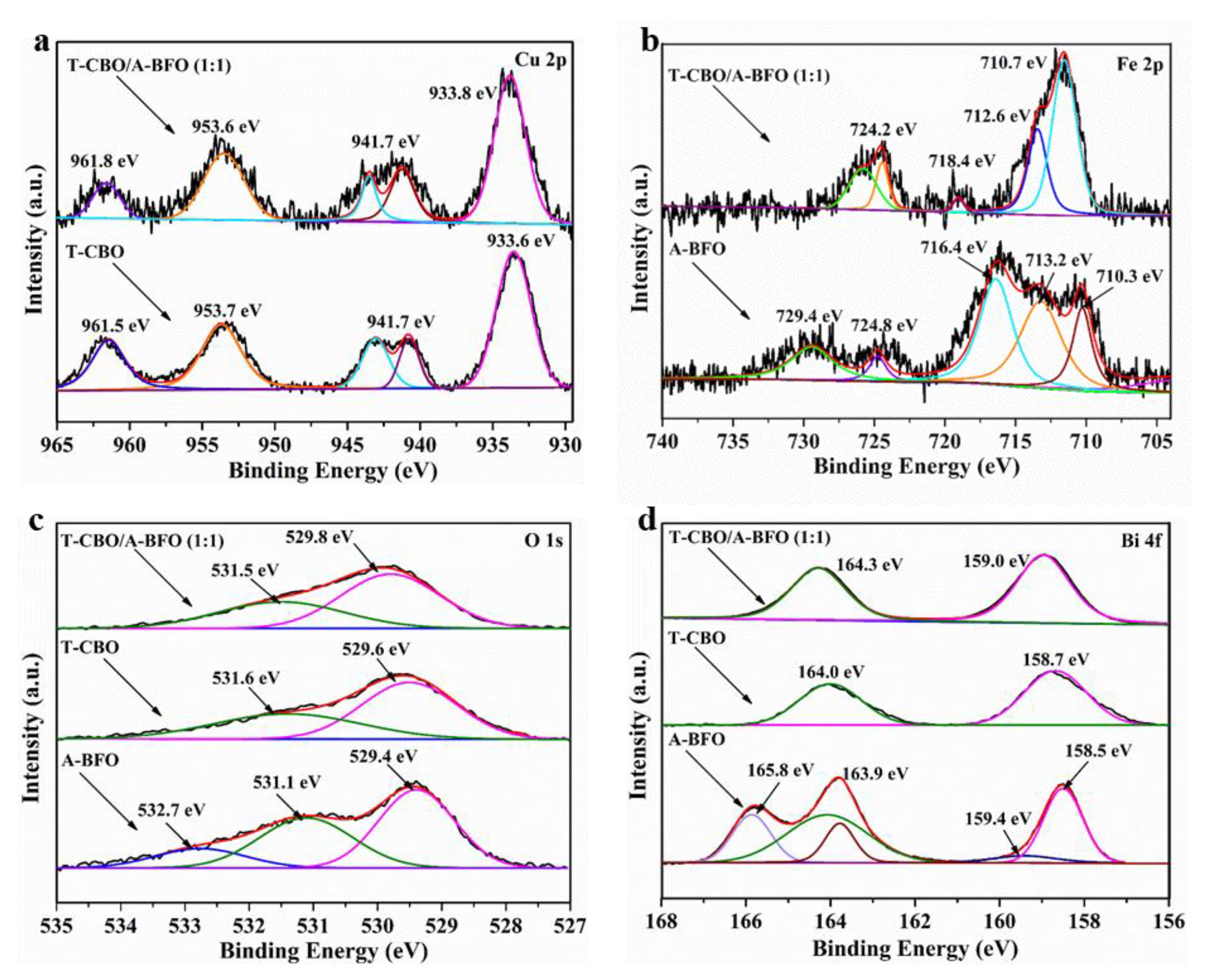
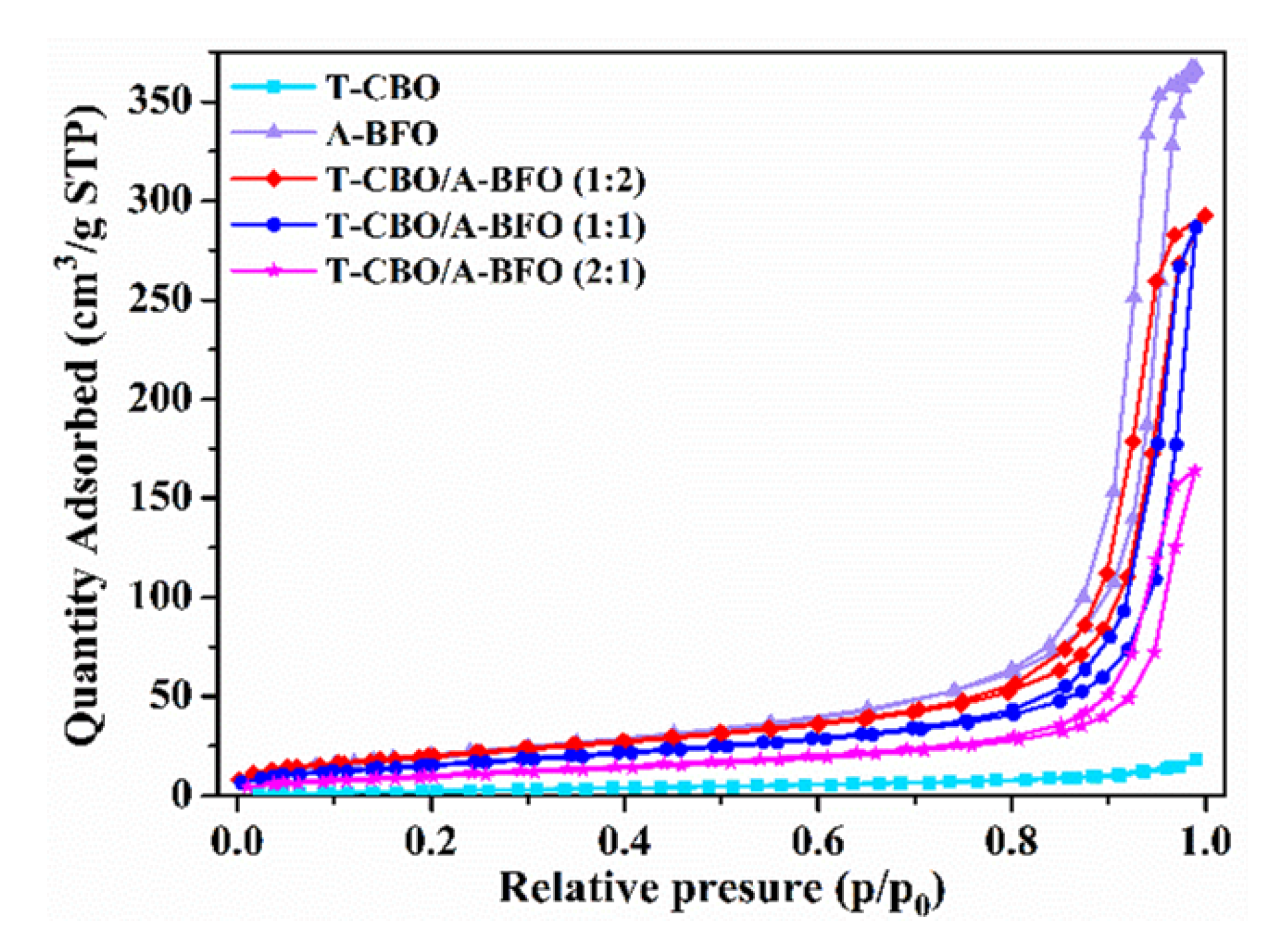
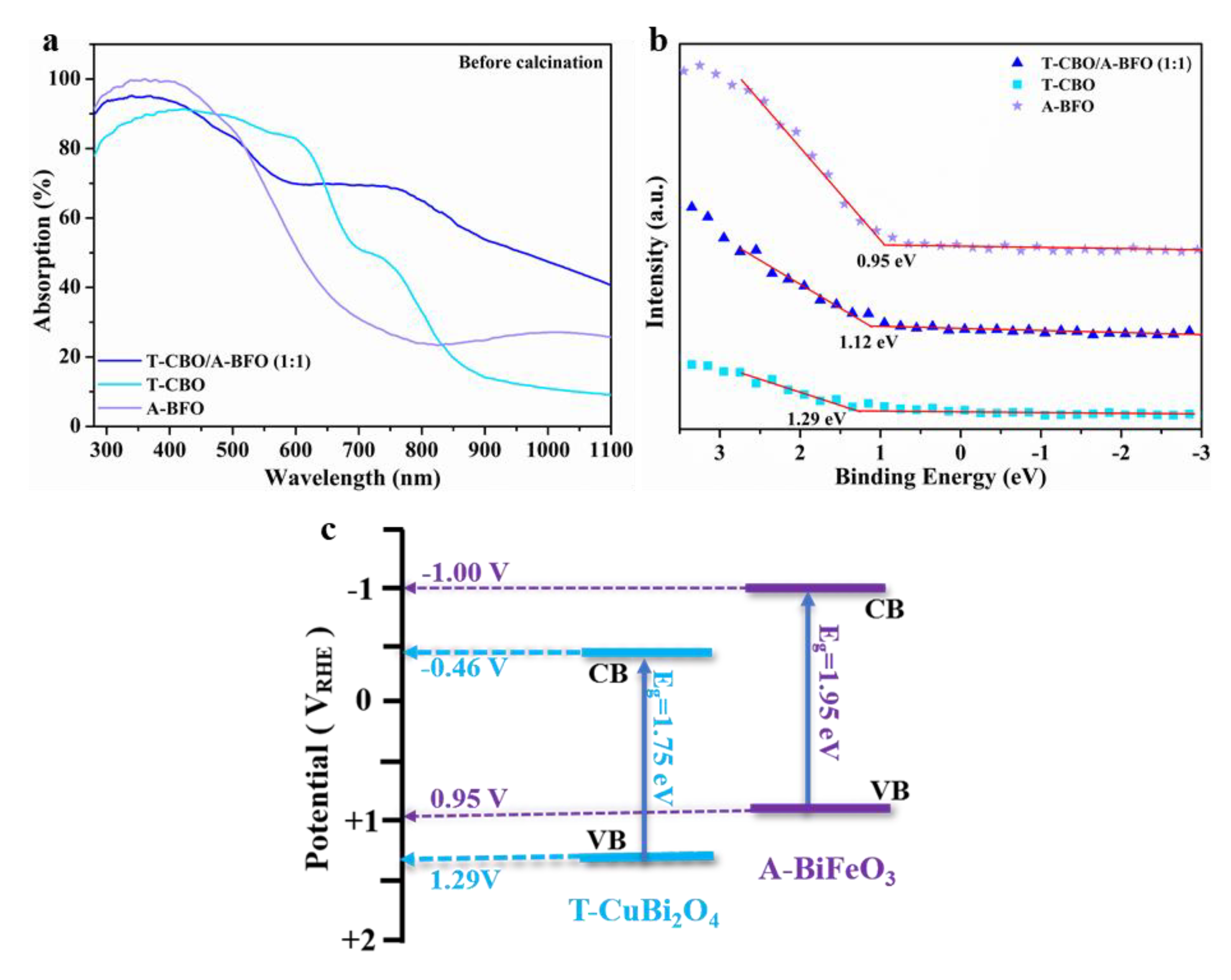
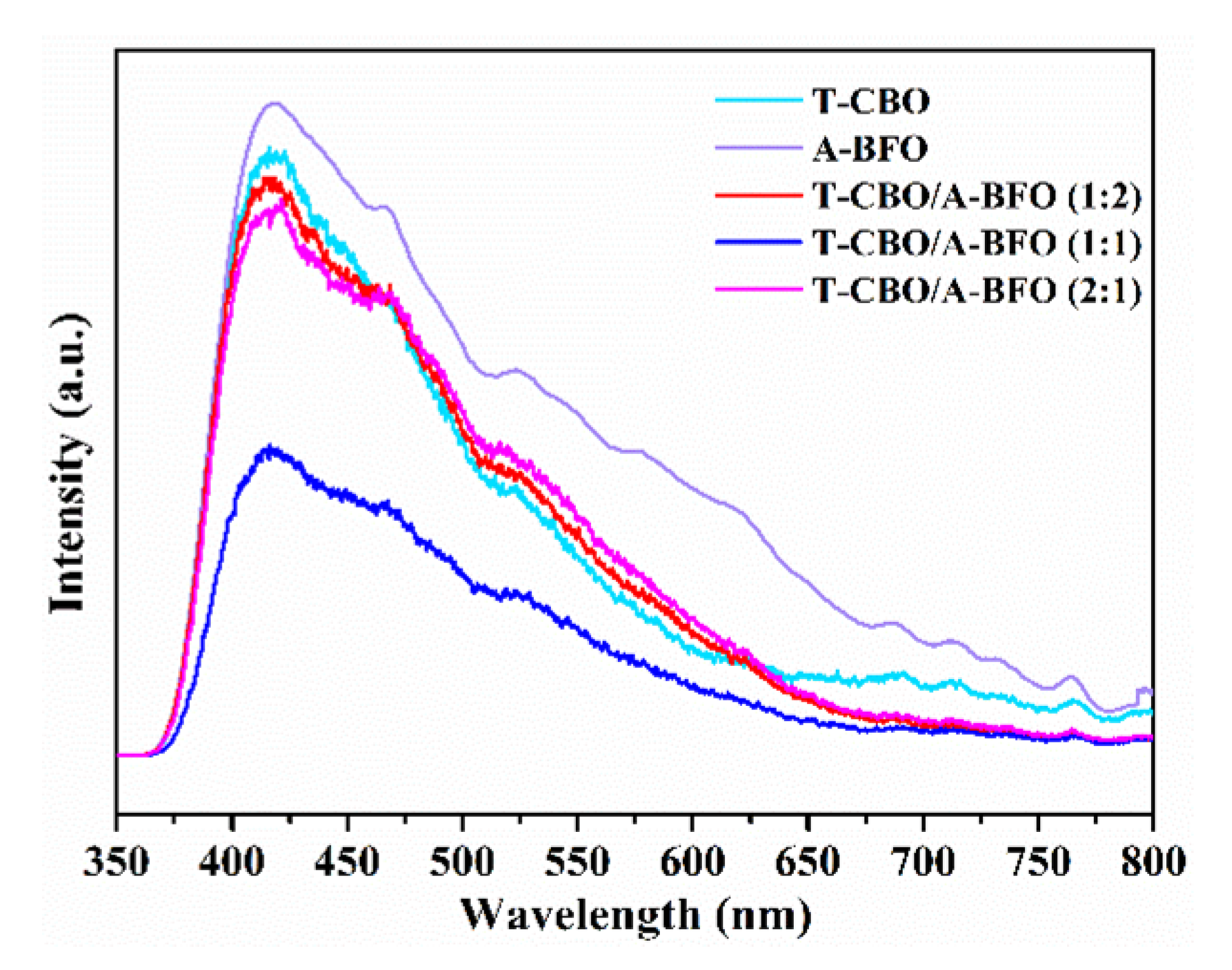
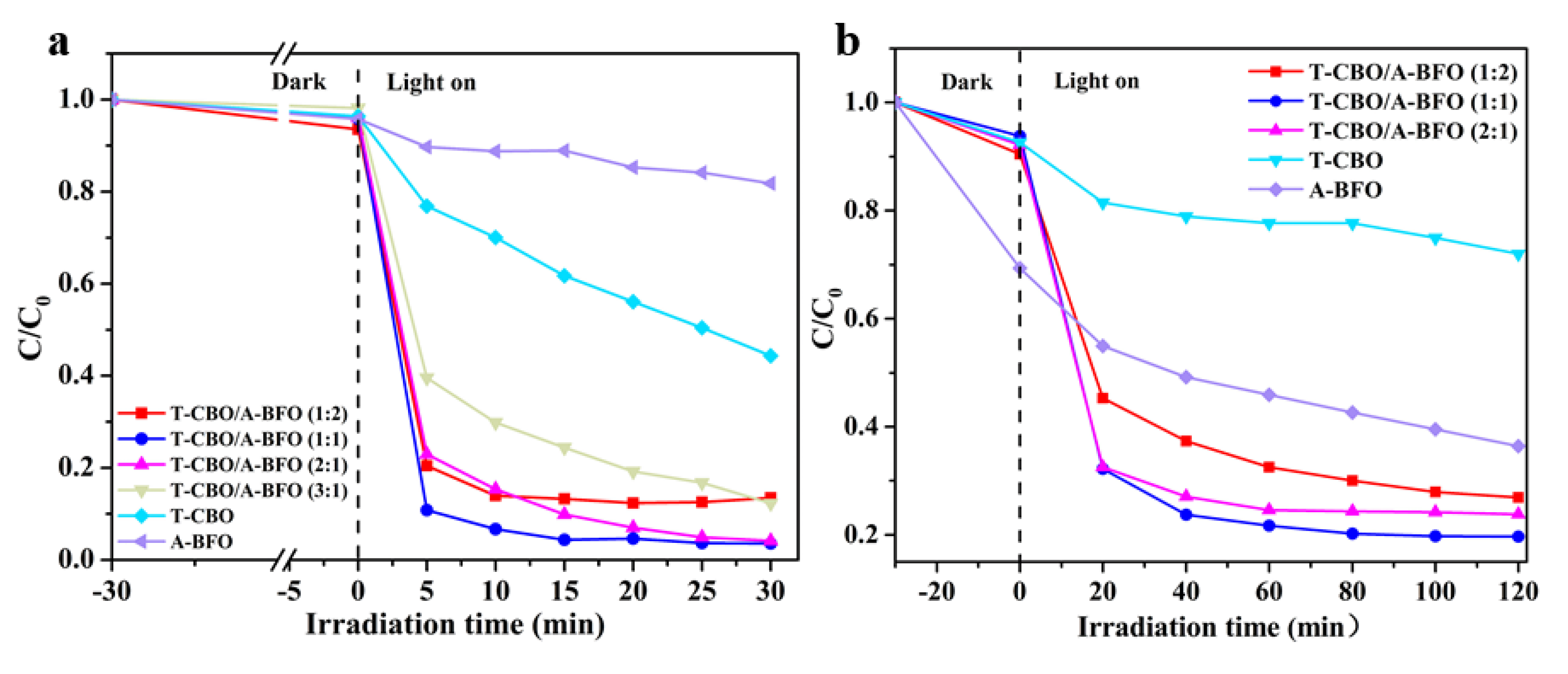
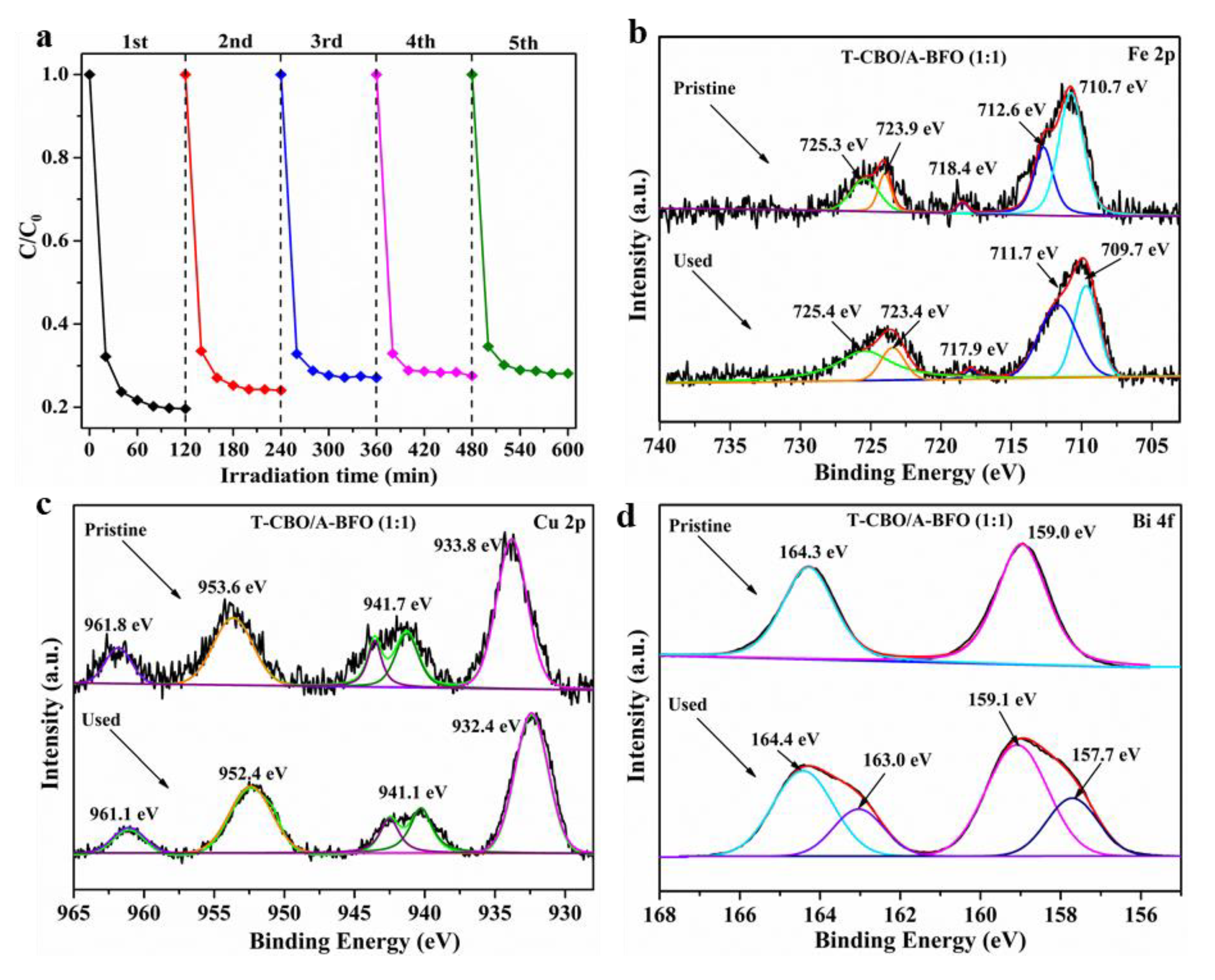
| Samples | T-CBO | T-CBO/A-BFO (2:1) | T-CBO/A-BFO (1:1) | T-CBO/A-BFO (1:2) | A-BFO |
|---|---|---|---|---|---|
| BET (m2/g) | 11.60 ± 0.39 | 38.95 ± 0.47 | 58.86 ± 0.48 | 74.18 ± 0.66 | 80.39 ± 0.63 |
| Pore volume (cm³/g) | 0.02 ± 0.01 | 0.19 ± 0.03 | 0.27 ± 0.08 | 0.41 ± 0.02 | 0.57 ± 0.01 |
| Average pore size (nm) | 6.82 ± 0.94 | 17.56 ± 2.25 | 21.78 ± 2.60 | 17.59 ± 1.19 | 28.22 ± 1.05 |
© 2020 by the authors. Licensee MDPI, Basel, Switzerland. This article is an open access article distributed under the terms and conditions of the Creative Commons Attribution (CC BY) license (http://creativecommons.org/licenses/by/4.0/).
Share and Cite
Cai, F.; Zhang, T.; Liu, Q.; Guo, P.; Lei, Y.; Wang, Y.; Wang, F. One Step Synthesis of Tetragonal-CuBi2O4/Amorphous-BiFeO3 Heterojunction with Improved Charge Separation and Enhanced Photocatalytic Properties. Nanomaterials 2020, 10, 1514. https://doi.org/10.3390/nano10081514
Cai F, Zhang T, Liu Q, Guo P, Lei Y, Wang Y, Wang F. One Step Synthesis of Tetragonal-CuBi2O4/Amorphous-BiFeO3 Heterojunction with Improved Charge Separation and Enhanced Photocatalytic Properties. Nanomaterials. 2020; 10(8):1514. https://doi.org/10.3390/nano10081514
Chicago/Turabian StyleCai, Fang, Ting Zhang, Qiong Liu, Pengran Guo, Yongqian Lei, Yi Wang, and Fuxian Wang. 2020. "One Step Synthesis of Tetragonal-CuBi2O4/Amorphous-BiFeO3 Heterojunction with Improved Charge Separation and Enhanced Photocatalytic Properties" Nanomaterials 10, no. 8: 1514. https://doi.org/10.3390/nano10081514




